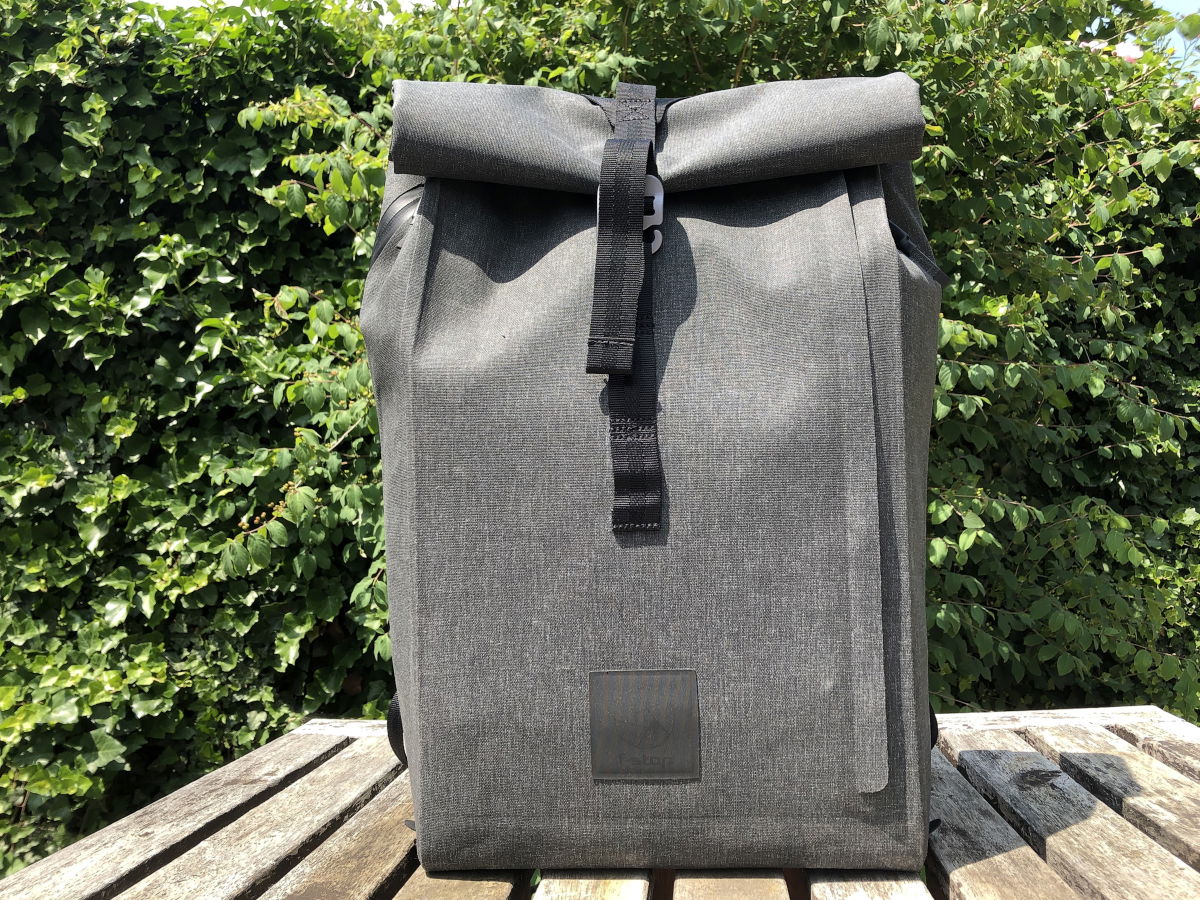The Canon R5 is a mirrorless camera that was announced by Canon on February 13, 2020. It features a 45.7 MP full frame CMOS sensor and Dual Pixel CMOS AF with 5,779 manually selectable focus points.
But at over three years old, is the Canon EOS R5 still a good camera in 2023? Read on to find out!
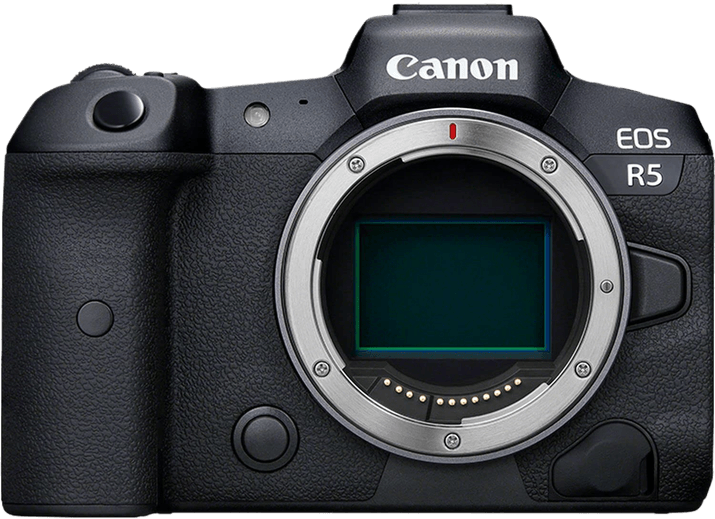

| Released |
Released
2020
|
| Sensor Format |
Sensor Format
|
| Lens Mount |
Lens Mount
Canon RF
|
| Megapixels |
Megapixels
45 MP |
| Autofocus Points |
Autofocus Points
1,053 |
| Maximum ISO (Native) |
Maximum ISO (Native)
51,200 |
| Frame Rate |
Frame Rate
20 fps |
| In-body Stabilization |
In-body Stabilization
|
| Video |
Video
|
But this camera is so much more than that. Its key features include a 20 fps burst mode, fantastic autofocus, outstanding stabilization, a durable weather-sealed design, and dual card slots. It is a continuation of the 5D series that has been the workhorse of professional photographers in a range of industry niches.
Canon has been building the R system for a couple of years now, releasing several exceptional lenses. Until now, high-quality camera bodies have been missing from the mix. Neither the EOS R nor the RP have been market-dominating cameras.
This is the first time since the introduction of the system that a fully professional model has entered the lineup. This opens up a range of new possibilities for Canon mirrorless users.
I tested the Canon EOS R5 with two RF-series lenses, the 70-200 f/2.8L IS and the 50mm f/1.2L.
I received this camera for a testing period of three weeks from Canon UK, along with the prior lenses. (Editor’s note: This article is not sponsored by Canon.)
The reviewed unit had firmware version 1.1.1 installed.
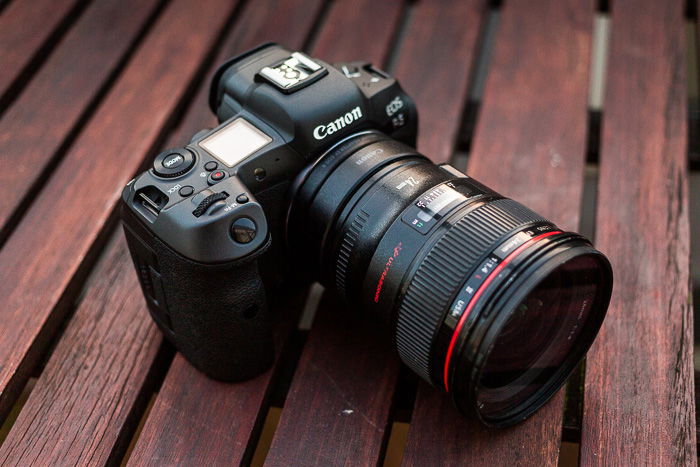
This camera is targeted toward professionals earning money from photography. But it’s also great for keen amateurs willing to invest in their passion to take it to the next level.
To fully appreciate the Canon EOS R5, you need high-quality EF lenses that fully utilize what this camera is capable of. The CFExpress memory cards are also not cheap, especially the larger versions optimal for 8K video file sizes.
There is a range of genres in which the EOS R5 can highly benefit its users. These include event and wedding photography, portrait, landscape, documentary photography, and photojournalism. But the Canon R5 also opens up completely new possibilities in photography for capturing high-speed, high-resolution imagery.
The R5 is most appealing to users who are already invested in Canon gear. EF lenses can be used without a loss in functionality. Its menu system, interfaces, buttons, and general layout are retained from Canon EOS DSLRs and EOS R models.
But I can absolutely imagine that this camera will attract new users to the platform because of its features. For the first time in years, Canon is showing hints of its former pioneer status.
I don’t recommend this camera if you’re just starting out in photography. It will simply be too overwhelming. Also, the notion of buying glass first still stands. However attractive the R5 might be, it still can’t achieve much without the proper lenses.
The Canon EOS R5 is built around Canon’s full frame mirrorless RF mount. This was introduced a few years ago with the EOS R and a few L-series lenses. Since then, a number of new L-lenses have been released (as well as several cheaper ones).
Professional lens options for the system include the 15-35mm f/2.8L, the 24-70mm f/2.8L, and the 70-200mm f/2.8L for journalistic work. It also offers the amazing 28-70mm f/2L and a few amazing primes such as the 50mm f/1.2L and 85mm f/1.2L.
The RF mount is one of the most technologically advanced. It has a short flange distance of 20mm and a diameter of 54mm (same as EF). And it has a high-bandwidth electronic connection for smooth autofocus, detailed metadata, and the function ring.
You can adapt Canon EF lenses (made for DSLRs) with relative ease. The EF communication protocol is natively supported by R cameras. The EF-RF adaptors are simple, pin-to-pin constructions for the most part.
This means there is no loss in autofocus speed or accuracy compared to EF-mount cameras with EF lenses. This is backed up by my real-life experiences, especially the 24mm f/1.4L II, which is the newest of my own EF lenses. It has a ring-type ultrasonic autofocus motor optimized for tracking autofocus.
Nearly all EF lenses released after 2008 have such motors, so these will perform best with the R5 in continuous autofocus. But even my 200mm f/1.8L, which was designed in the 80s, functioned reasonably well during testing. It was a much better focusing experience than with the EOS R and EOS RP.
Adapting non-Canon lenses is also possible thanks to the short flange distance. But due to a smaller user base, adaptors are less widely available than for Sony’s E-mount. The same is true for native third-party lenses.
You can adapt old manual lenses too. Manual lens operation is made easier with EVF magnification and focus peaking.
The Canon EOS R5’s 45 MP full frame sensor is the biggest jump in megapixels in almost a decade for Canon. Canon has been criticized for using its own subpar sensors in new models. These performed worse in low-light conditions and provided a tighter dynamic range than direct competitors. But this new sensor has almost entirely caught up.
The R5’s sensor is an excellent performer in low light. It gives almost 14 stops of real dynamic range at base ISO, which is retained very well until around ISO 6400. It includes a not-too-harsh low-pass filter, so the images you get are sharp. The portrait below was shot at ISO 8000 in near pitch black, close to the -6EV limit of the AF system.
Helped by the in-body stabilization and a fast 50mm lens, this camera is basically capable of night vision. Oh, and did I mention that the autofocus picked up and tracked her eye?
 The full-size image files are 8192 x 5464 pixels. This specific resolution allows the camera for uncropped DCI 8K recording, which is 8192 x 4320 pixels.
The full-size image files are 8192 x 5464 pixels. This specific resolution allows the camera for uncropped DCI 8K recording, which is 8192 x 4320 pixels.
In either RAW or JPEG shooting, the R5‘s files are exceptional. In JPEG, the default colors look natural, rich, and somewhat warm. In RAW, the files allow for a previously unseen exposure recovery extent and very detailed shadows.
Canon has included the new HEIF format first introduced in the 1DX. This is a web-friendly compressed 10-bit format. It’s optimized for the high dynamic range screens found in some new laptops, smartphones, and smart TVs.
For shooting RAW, you can choose between lossless compressed CR3 (about 50 MB each) and compressed CR3 (around 25 MB) files. The latter seems to preserve all information even in areas of extreme tonality. The only difference I could find is a very slight increase in color noise in shadows.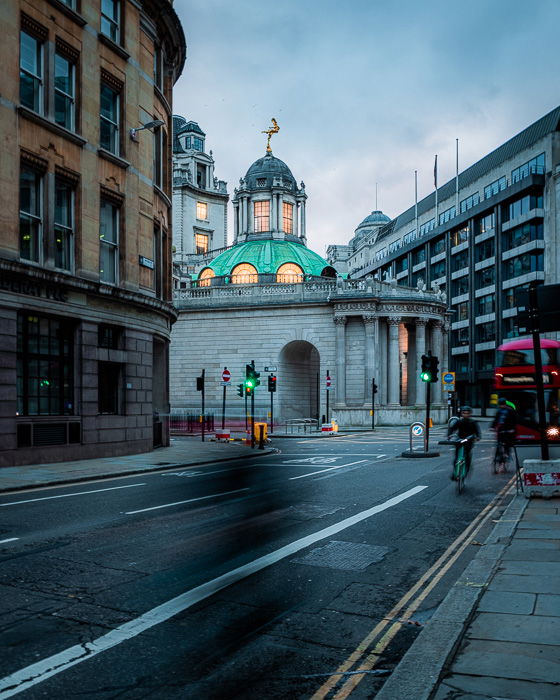
Not only does this sensor give great image quality, it is also stabilized. Canon claims that on its own, the system is capable of up to 7 stops of stabilization with select unstabilized RF lenses, and up to 8 stops with stabilized RF lenses.
My experiences confirm this. I did rough calculations based on my own results, which I usually find to be generalizable.
The RF 70-200 f/2.8L IS does indeed give you the promised 8 stops, and the RF 50mm f/1.2L gives 6.5 stops. I got around 4.5 stops with my 24mm f/1.4L II, and 3-3.5 stops with the EF 40mm f/2.8, 50mm f/1.2L, 85mm f/1.8, and 200mm f/1.8L lenses.
These differences can be explained by the variation of the sizes of their respective image circles, and that the camera takes this info into consideration.
There is an interesting phenomenon with wide-angle lenses. And it gets stronger the wider you go. At very slow shutter speeds (over 0.5 sec), sometimes the center of the image is tack-sharp but the edges have motion blur. This is because while the sensor is doing its job and maneuvering around to stabilize, it cannot counteract the changes in perspective as the camera shakes.
Still, this performance is jaw-dropping. It places Canon’s sensor stabilization at the very top of the market. Previously, Micro Four Thirds cameras have been capable of only slightly worse results.

The Canon EOS R5 benefits from a revamped Dual Pixel autofocus system. This is an on-sensor phase-detection system and it’s extremely powerful. It’s the same algorithm as the one used in the 1DX Mark III’s Live View mode. But here it works with twice the information because of the higher-resolution sensor.
The R5 is the first camera I’ve ever used that I could just keep continuous tracking mode on and not miss a single shot. I only switched to a single-point one-shot to confirm that the former is indeed equally precise—and it is.
Subject recognition is accurate and reliable, especially with human and animal faces and eyes. I used center-point initiated tracking 80% of the time. The camera would lock on to literally anything and keep it in focus for as long as I wanted. This is true in low light and even with fast-moving subjects. It is also very sensitive. Rated at -6 EV, the R5 catches focus in the darkest of environments.
The system starts to track eyes instead of the face when the face occupies roughly 20% of the frame vertically. This is slightly better than Sony’s performance from the A7R IV and way better than any Canon camera before.
You can configure the autofocus to specific situations. But there are built-in presets optimized for different types of movement.
As in almost all mirrorless cameras, the Canon R5 focuses with the aperture stopped down.
All in all, this is the best autofocus system I have ever tested.
In terms of continuous shooting, the R5’s performance is also impressive. It is capable of 12 fps with the mechanical shutter and 20 fps with the electronic shutter, both with the tracking autofocus fully engaged. This peak performance can only be achieved when the battery is close to fully charged, though. And closing down the lens also slows it down. Still, this is nothing short of extraordinary in a 45 MP camera.
I’ve found the electronic shutter mode to be fine in terms of rolling shutter artifacts. I managed to make it quite visibly show up on video. But you’re unlikely to pan so quickly during photography that it would become an issue.

To fully utilize these framerates for longer than about two seconds, you’ll need to use a CFExpress card in the primary slot. You’re asking the camera to transfer twenty 50-MB files every second. That’s not something SD cards can handle.
When rumors first started spreading about the Canon EOS R5, one of the first signs that something serious is happening was the 8K RAW video feature. And this has since become one of the most infamous capabilities of the camera.
As soon as the first production models hit the shelves, reports started to come in that the R5 overheats quickly. Canon was forced to release official estimates on overheating and recovery times. It was also circulated that the whole thing was just a marketing stunt and Canon wants to preserve usable 8K features for the cinema camera lineup.
The truth is probably not so blunt. Before the R5, nothing even came close to this performance in the mirrorless world. What the R5 is capable of will serve as a benchmark for further Canon cameras and as a kick forward for the competition. Ultimately, this benefits us photographers the most.
The EOS R5 gives you a range of impressive video features. Beyond 12-bit 8K/30p RAW, its 10-bit 4K/30p footage is possibly the best I’ve seen. It is capable of shooting 10-bit 4K and 1080p at up to 120fps. In 4K, there is an HQ mode available. This is directly downsampled from the 8K signal and results in the sharpest 4K footage I’ve seen to date.
Of these, 8K/30p, 4K/120p, 4K/60p, and 4K HQ are limited by overheating to varying degrees. In 8K and 4K/120p, it’s around 20 minutes and around 30 minutes for 4K/60p and HQ. Recording and recovery times have been improved with firmware updates since I conducted this review. The firmware version at the time of testing was 1.1.1.
Autofocus works beautifully with each of these modes. It’s no match for a professional focus puller, but the EOS R5’s smoothness and accuracy is pleasantly surprising.
When switching modes, there are conveniently separate M, Tv, Fv, and Av modes for video. By default, you store different settings in these than in stills modes, but you can change this in the menu.
As I mentioned, the rolling shutter is visible in all of the video modes. But it’s decently well controlled and not an issue in general use.
The camera can output clean footage in any of the recording formats to external recorders via a micro-HDMI port. There are also 3.5mm headphone and microphone jack ports.
With a USB-C cable and Canon’s EOS Webcam Utility software, you can use the R5 as a moderately overpriced webcam.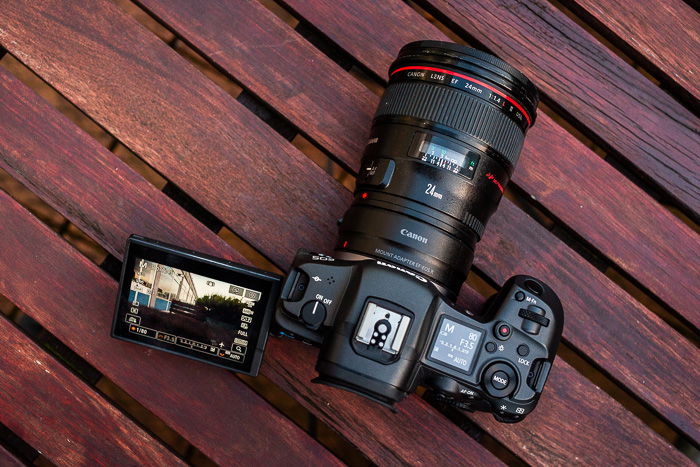
As a successor to the famously well-built 5D series, there is some pressure on the R5 to be similarly comfortable and durable. It seems to do a great job, though.
The body is built on a magnesium-alloy frame with the usual rubber coating. It is fully weather sealed. It doesn’t feel as tough as my 5D Mark III, but I attribute this to its smaller size and my own lighter touch.
It measures 138 x 98 x 88 mm and weighs 738g. This is slightly larger than the original EOS R but still way smaller than the 5D series.
In terms of ergonomics, the R5 shares first place with Panasonic’s larger mirrorlesses. Everything about the design is laboriously thought out, well-placed, and comfortable.
The grip is beefy and allows for firm holding. And the shutter button is placed perfectly.
There are three fully customizable dials, so you can map all three exposure settings to a separate dial. The on/off switch got a bulge that makes it much easier to flick. The joystick is right where the thumb naturally sits. Although, it hasn’t seen as much use as usual because of the incredible tracking focus. There are enough function buttons to get one for all the adjustments you usually make, plus at least one. I ended up not using two.
One of my favorite buttons on professional Canon cameras is the “rate” button. This enables you to rate your shots from one to five stars in-camera so that you can already start the selection before importing.
It is joined by the Voice Memo feature on the R5, with which you can add your on-the-spot notes to images and videos. This is incredibly useful in many situations from journalistic work to portrait sessions. 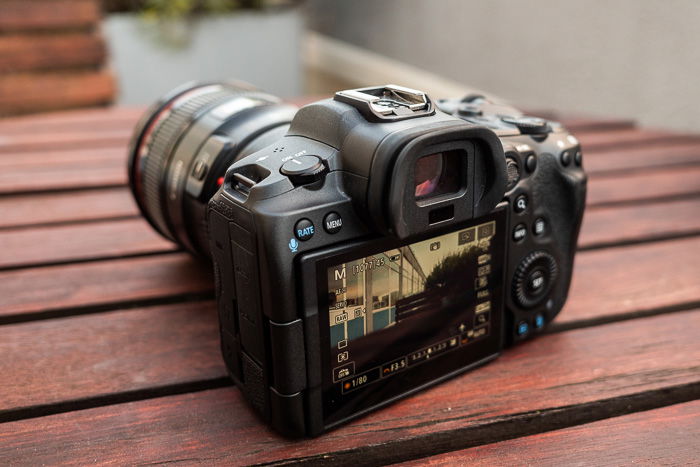
A large, flip-out touchscreen LCD occupies a significant part of the back. Canon has perfectly integrated the touchscreen into the operations of this camera. Everything is intuitive and straightforward.
The electronic viewfinder is among the best I’ve used. With a resolution of 5.76M dots (roughly Full HD), a refresh rate of 120 fps, and 0.76x magnification, this is a very usable option. It’s still no match for the optical experience, but it doesn’t really have practical issues. It actually has advantages over that, including blackout-free shooting and live exposure preview. It’s on par with the best in class.
There is a secondary LCD on top of the camera showing the current exposure settings and other parameters. These have largely gone extinct with the invention of mirrorless cameras. So I’m relieved Canon has kept it from the 5Ds and the R.
There is a new battery introduced with the Canon EOS R5. The LP-E6NH is backward compatible with the LP-E6 batteries used in nearly all pro cameras by Canon. It allows for 300 to 500 shots in one charge depending on the type of use.
Still, with the weight savings compared to a DSLR, you can fit a few extra batteries. Also, the R5 allows you to charge your battery in-camera. And this feature works with older LP-E6 and LP-E6N units as well.
The EOS R5 offers dual card slots—a CFExpress and a UHS-II SD. CFExpress cards are expensive. But they’re necessary to take full advantage of the high-resolution burst and video capabilities of this camera. They also feel much more durable and harder to break than SDs.
The camera is very well connected. It offers smartphone control and image transfer via AC Wi-Fi and geotagging via continuous Bluetooth LE connection.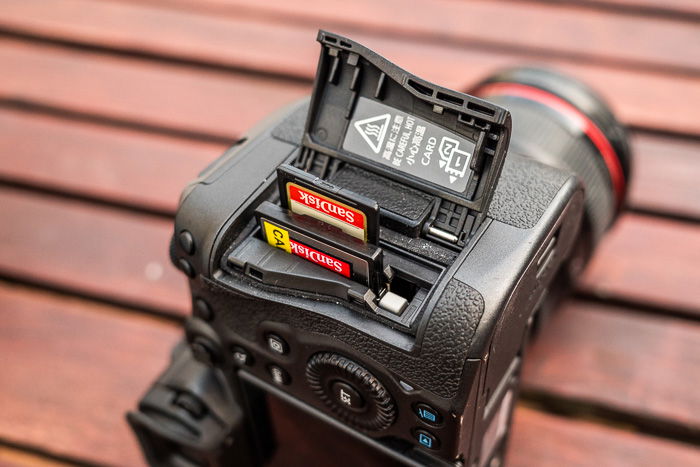
The Canon EOS R5 is a fantastic camera that only a few others can compete with.
The Sony A7R IV is perhaps the closest. This is a 61 MP full frame mirrorless camera, which overtakes the R5 in sheer image quality and dynamic range in particular. Its autofocus is also close, though not on par. However, it doesn’t come close to the burst performance of the R5. Also, Canon’s high-quality lens collection is arguably better than Sony’s. It’s possible that the marginal difference in pixel count is offset by the sharpness of some new RF lenses, such as the RF 50mm f/1.2L.
If you’re looking for a Canon experience and similarly powerful features but don’t need the high resolution, the Canon EOS R6 might be a perfect choice for you. For much less money, it retains all the class-leading features of the R5 except for the higher resolution and resulting lack of 8K video. There are also minor changes, such as dual UHS-II SD slots, the annoying removal of the top LCD, a different mode selection method, and slightly different build materials.
If you’re a Nikon shooter, the closest you’ll get to the EOS R5 in performance is with the Nikon Z7 II. This camera gives a slightly better dynamic range in a very similar 45.7 MP resolution. Its ergonomics and controls, although different from Canon’s, are well thought-through. Its autofocus system is reported to have been vastly improved compared to its predecessor. The Z7 II doesn’t shoot 8K and 4K/120p, but it does shoot 4K RAW video. That’s arguably more practical than 8K RAW. At the moment, Nikon’s Z-mount has more budget-friendly optics available than Canon’s RF.
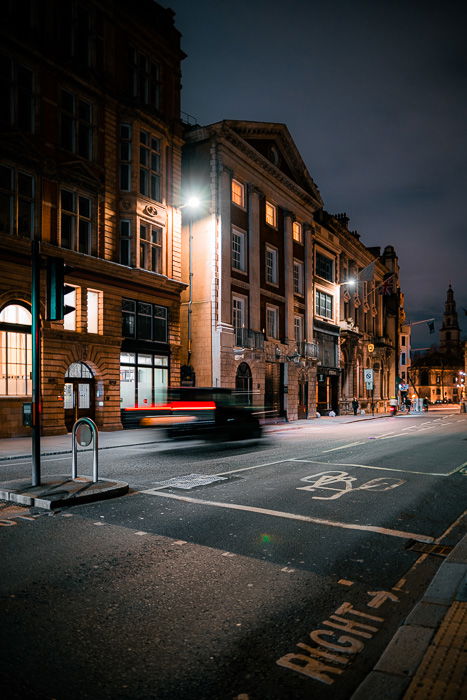
The Canon EOS R5 finally places Canon back on the market, providing an edge that will take some time to catch up to. It is quite possibly the best overall camera package for stills photography. Its resolution, autofocus, stabilization, lens options, and burst capabilities form a feature set that is, in combination, unsurpassed.
It’s also excellent for hybrid (stills/video) use. Despite the somewhat harsh criticism, it does everything in terms of video features that the competition can do.
Clearly, Canon has aimed to set the bar very high this time. And they have succeeded.
| Measurement |
Measurement
Score
|
| Main Features |
Main Features
|
| Extra Features |
Extra Features
|
| Construction and Durability |
Construction and Durability
|
| Handling and Ergonomics |
Handling and Ergonomics
|
| Value for Money |
Value for Money
|
| Total Score |
Total Score
|

